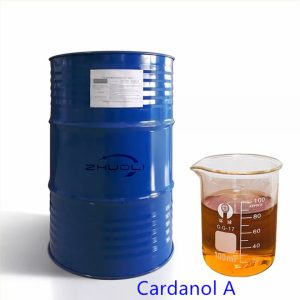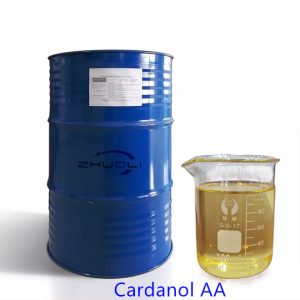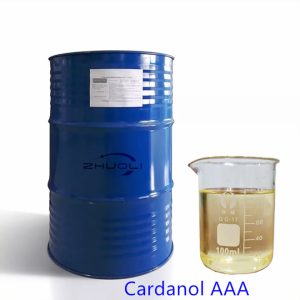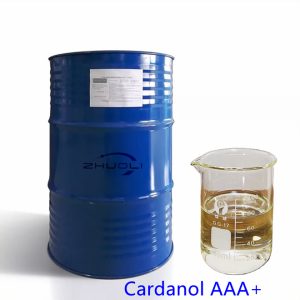Cardanol
Cardanol also known as Cashew Phenol is obtained in the distillation process of technical CNSL under reduced pressure. It is a monohydroxyl Phenol having a long hydrocarbon Chain (C15H27) in the Meta position. The distillation takes place at high temperature and Distilled CNSL vapours are received through high vacuum. Cardanol has an aromatic ring that provides a strong chemical resistant backbone while the hydroxyl group gives strong adhesion and good reactivity for fast and low temperature cure. A long aliphatic side chain provides excellent water resistance, good flexibility, low viscosity, extended pot life, and excellent corrosion protection.
The properties of Cardanol:
- The cardanol residual formed with the distillation of CNSL can be used in producing friction dust in rubber compounding and brake linings.
- Cardanol is a renewable and cheap material with increased adaptability.
- The derivatives of Cardanol are utilized in the laminating industry to minimize brittleness and enhance the flexibility of laminates.
- It has quick drying properties after baking, high thermal conductivity, electric conductivity, and great flexibility.
- They are resistant to the smoothing effects that mineral oils have.
- Cardanol offers good resistance to the alkaline solution and insects.
- The molecular structure of this material is unique, with long hydrocarbon chain components which makes structure cross-linking simple.
- The polymer structure of this material is weather and water-resistant due to its hydrophobic features.
Applications of Cardanol:
Oil Soluble Resins:
The meta substitution and long hydrocarbon chain in its molecule make Cardanol resins extremely soluble in oils and provide excellent characteristics such as strong electric insulation and chemical resistance to its films. Depending on the nature of the catalyst and the aldehyde molecule, it is to make both solid and semisolid resol or novolac type resins.
Rubber compounding:
Rubber compounding employs oil-soluble cardanol resins. They have a high tear strength and are resistant to petroleum-based solvents. When pure cardanol is mixed with rubber, it works as a deoxidant and plasticizer. Its ether is also utilised in synthetic rubber as a plasticizer to lower shore hardness and enhance ageing characteristics.
Lamination Industry:
By substituting phenol or cresol for a portion of the phenol or cresol in alcohol-soluble resins used for lamination, it is possible to create resins with increased flexibility, resilience to chemicals and water, and improved electrical insulation for lamination sheets. Surface active agents (Emulsifiers, dispersants and wetting agents): Ethoxylated cardanol and sulfonated ethers of cardanol are used as oil in water emulsifiers in pesticides and as wetting agent in textile industries.
Adhesives:
Water-resistance and bonding characteristics of plywood are enhanced by adhesives based on cardanol resin. Cardanol may be used to make a variety of adhesives and cements. In the presence of epichlorohydrin and phthalic anhydride, a coating compound with good film characteristics and adhesion may be produced from the reaction. Cardanol, which is used in brake linings and clutch facings, may be used to make a high-quality friction dust.
Surface Coatings & Paints, Marine Coating:
The Cardanol based resins have good compatibility with other synthetic resins such as alkyds, epoxies chlorinated rubber, phenolic etc., and can serve as raw material for variety of paints. The Cardanol based resins have an excellent anti-corrosive characteristics
Pesticides:
As a disinfectant and germicide, chlorinated cardanol has been found to be effective. Also, pyrethrin and rotanes are dissolved in cardanol formaldehyde resins, which are also employed as solvents for insecticides. Isocyanurate tetra hydro Cardanol is used in sprayable insecticides like parathion as a coupling compound.




